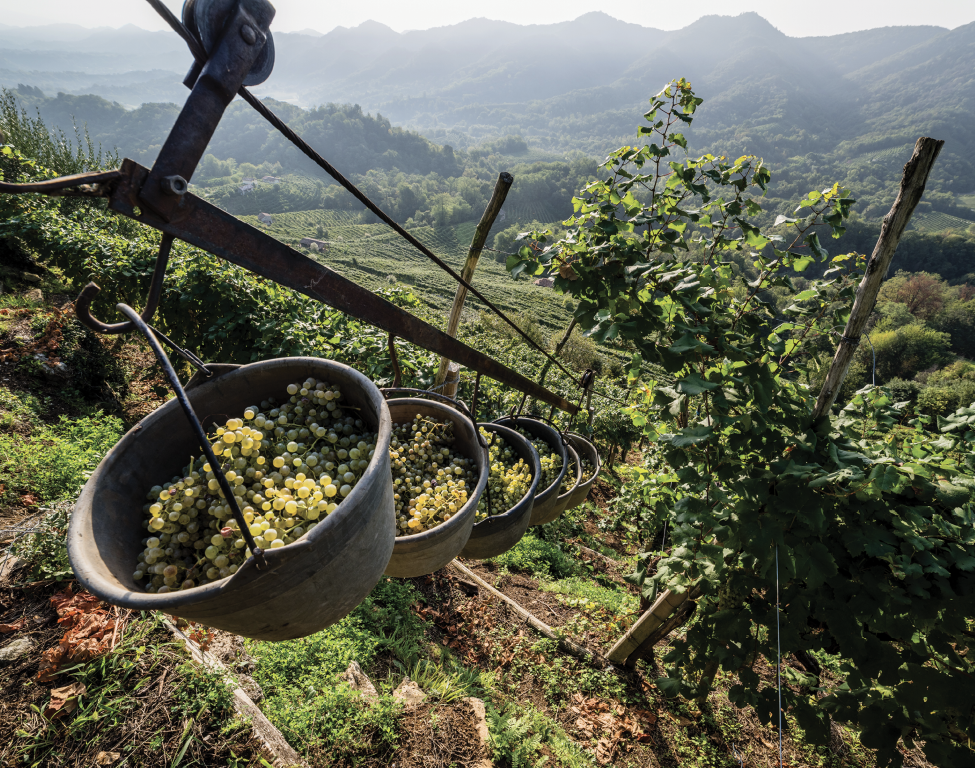
It’s a good time to be in the prosecco business. Over the past 15 years, Prosecco sales have shot sky-high to reach 700 million bottles each year. Easy drinking and a great value, Prosecco has become synonymous with sparkling wine and good times. And yet, the people behind the wines would respectfully like to remind us that Prosecco is not just another name for bubbly. It’s a special place with a noble tradition: Prosecco is a historic sparkling wine region in the Veneto and Friuli area of northeastern Italy.
After centuries of history, Prosecco waited a long time to claim its winemaking legacy. Post-millennium, just about everyone producing cheap bubbly—anywhere in the world—was calling it Prosecco. In 2008, Paris Hilton became the cover girl for an upstart “Prosecco” from Austria, appearing in high heels and tabloid glory to help sell it in 27 countries. Her gold-painted body was depicted on cans available in various fruit varieties, a far cry from what Italian producers envisioned for their wine reputation. It was too much to ignore. “Paris Hilton is sensationalism. It’s not good. It’s not adequate for Prosecco,” declared an infuriated Fulvio Brunetta, president of the Prosecco winegrowers’ association. One year later, Prosecco formed an official regional organization to establish three strictly controlled winemaking areas: Prosecco DOC, the largest production zone, which extends across the regions of Veneto and Friuli; Conegliano Valdobbiadene Prosecco Superiore DOCG, the steep hills and historic center just north of Venice; and Prosecco Asolo Superiore DOCG, near the town of Asolo. Thanks in part to Paris Hilton, nothing produced outside these areas can legally be called Prosecco.

Made predominantly from a local white grape variety called Glera, Prosecco comes in a range of sweetness, from the driest Brut to medium-sweet Extra Dry and the sweetest “Dry” wines. By popular demand, Prosecco DOC also offers an official Rosé style made from Pinot Noir. It’s a common misperception to think that all Prosecco is sweet. Most Prosecco wines are produced in a dry Brut style; however, Glera is a fruit-forward grape with notes of green apple, honeydew melon, pear and honeysuckle that naturally tastes sweeter than Champagne. Often compared to Champagne, Prosecco is usually made very differently, earning its bubbles through a gentle fermentation process in large stainless steel tanks (versus the traditional bottle fermentation method of Champagne, which is far less common in Prosecco). The popular tank method of making Prosecco debuted at the turn of the 20th century and allows producers to make quality sparkling wine on a large scale. For a more ancestral taste of Prosecco, some producers also offer a “Col Fondo” or pét-nat (pétillant naturel) style with traditional fermentation in bottles; the spent yeast leaves a fine residue on the bottom (fondo in Italian), which results in a cloudy appearance with earthy apple, mineral and citrus flavors.


Claudia Manetta, export manager for La Marca Prosecco, one of Italy’s leading wines, has had a front row seat to watch Prosecco’s meteoric rise. Originally from Bergamo in northern Italy, Manetta relocated to her husband’s hometown in the Veneto to join La Marca, just as things were getting frothy in 2008. Many Italians were also just getting to know Prosecco. “When I moved to Treviso, it was new to me as well to enjoy a spritz as an aperitivo. Prosecco is so friendly and affordable,” Manetta recalls. Just north of Venice, Treviso is an ideal vantage point to discover the region: the nearby towns of Conegliano and Valdobbiadene are home to the best Prosecco DOCG. The rolling hills frame a picturesque landscape worthy of a Renaissance painting; they also create the exposure, microclimates and mineral-rich terrain that distinguish Prosecco DOCG (handpicked from steep, sloping vineyards) from Prosecco DOC (grown on the valley floor).

LA MARCA PROSECCO LUMINORE DOCG
($25)
NAMED FOR THE MORNING LIGHT ON THE VINES, LUMINORE IS SOURCED FROM THE HILLS OF PROSECCO DOCG. DELICATE AROMAS OF WHITE FLOWERS, PEAR AND NECTARINE. SOFT AND CREAMY, WITH A LIGHT, REFRESHING FINISH.

LA MARCA PROSECCO ROSÉ DOC
($18)
PROSECCO ROSÉ FIRST DEBUTED IN 2020. LA MARCA BLENDS 10% TO 15% PINOT NOIR WITH THE LOCAL GLERA VARIETY FOR A LOVELY BLUSH COLOR. CRISP AND SATISFYING, WITH BRIGHT CITRUS AND WILD STRAWBERRY FLAVORS.

CA’ DEI ZAGO VALDOBBIADENE PROSECCO COL FONDO DOCG 2020
($26)
FROM A FIFTH-GENERATION FAMILY WINERY IN THE HEART OF HISTORIC
VALDOBBIADENE, THIS IS A BIODYNAMIC WINE MADE IN THE COL FONDO STYLE. LIVELY AND PURE WITH NOTES OF HONEYSUCKLE AND WET STONE.
Like many Prosecco producers, La Marca has a foothold in both growing areas and makes a range of wine, including its iconic Tiffany-blue label, a global bestseller. Founded in 1968 as a cooperative between multiple wineries in Prosecco DOC and Conegliano Valdobbiadene Prosecco DOCG, La Marca is made up of 5,000 local growers managing some 38,000 acres of vines, an astounding 25% of the region’s output. As Manetta shares, the average vineyard size per grower is about 7 acres, but many parcels are closer to 1 acre, not much larger than a suburban backyard. In a co-op model, family growers secure long-term contracts and benefit from shared technical expertise at every step of production. Access to a consistent supply of quality grapes has real benefits: The entry-level La Marca Prosecco is affordable and tasty with flavors of green apple, peach and lemon.
Prosecco is such a big part of our wine-drinking culture it’s hard to remember a time when we didn’t reach for it at brunch, happy hour or to top a spritz. For Manetta and friends, meeting for aperitivo hour—usually an Aperol-style spritz at the end of the day—is a part of life. Nothing fancy, this slice of la dolce vita costs about four euros a glass. “You always get a small bite to enjoy, like salty nuts, chips or grissini with prosciutto,” Manetta shares. “The acidity and structure of Prosecco works well with many foods, and we don’t save it for weekends.” The simple pleasure of sharing a well-made bubbly with friends is at the heart of Prosecco, which Manetta believes is the most valuable export of the region. “Prosecco stands for a specific territory, a tradition rooted in this small part of Italy where great care is taken to make the wines. We didn’t start out making a wine to export; Prosecco is the wine the locals love to drink.” *
Helen Gregory is the founder and president of Gregory + Vine. She has worked in strategic brand management and communications for beverage industry leaders such as Moët Hennessy USA, Rémy Cointreau and STOLI, and has led award-winning hospitality, beverage and lifestyle campaigns for prestige clients from the European Union to Argentina, Australia, Chile, Israel, South Africa and across the United States.

